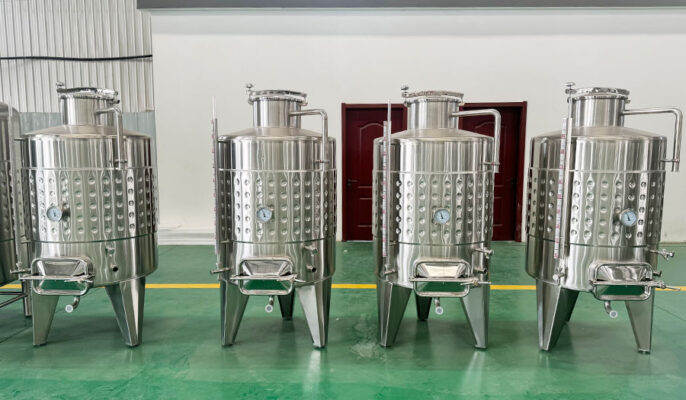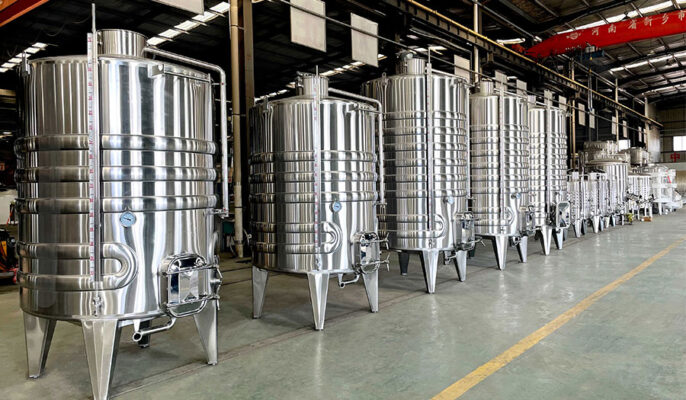스테인리스 스틸 발효기에서 와인을 숙성하는 것은 와인의 신선도를 유지하면서 정밀한 온도 조절이 가능한 믿을 수 있고 효과적인 방법입니다. 스테인리스 스틸 와인 발효기는 현대 와인 제조 산업에서 핵심 장비로 필수적입니다. 이 가이드는 스테인리스 스틸 와인 발효기의 모든 측면에 대한 포괄적인 개요를 제공하여 와인 발효기에 대한 보다 심층적인 이해를 돕습니다.
와인이란 무엇인가요? 발효 탱크? 어떻게 작동하나요?
와인 발효 탱크는 와인을 만들 때 포도즙을 발효시키는 데 사용되는 용기입니다. 발효는 포도 주스의 당분을 알코올과 이산화탄소로 전환하는 것입니다. 와인 발효 탱크의 디자인과 재료는 발효 과정의 효과와 와인의 품질에 직접적인 영향을 미칩니다. 많은 발효 탱크에는 적절한 발효 온도를 유지하고 효모 활동을 최적화하기 위한 온도 제어 시스템이 있습니다. 온도가 너무 높거나 낮으면 발효 과정의 효율성과 와인의 풍미에 영향을 미칠 수 있습니다.
발효의 주요 단계에는 1차 발효와 2차 발효가 있습니다. 1차 발효는 일반적으로 7~10일 동안 지속되며, 2차 발효는 수개월 또는 수년 동안 지속될 수 있습니다. 와인 메이커는 최종 와인의 품질을 보장하기 위해 발효 온도, 시간 및 기타 조건을 정밀하게 제어해야 합니다.

스테인리스 스틸의 종류 와인 발효 탱크
원통형 발효 탱크
가장 일반적인 발효 탱크 모양은 일반적으로 대규모 상업용 와이너리에서 사용됩니다. 원통형 디자인은 포도즙과 효모를 고르게 혼합하는 데 도움이 되며, 발효 과정에서 발생하는 가스를 효과적으로 처리할 수 있습니다. 모든 규모의 생산, 특히 중대형 와이너리에 적합합니다.
타원형 발효 탱크
원통형에 비해 타원형 발효 탱크의 바닥이 비교적 평평하여 발효 과정에서 생성되는 침전물이 탱크 본체에 미치는 영향을 줄일 수 있습니다. 침전물의 간섭을 줄여야 하는 와인 제조 공정에 적합합니다.
온도 제어 발효 탱크
- 냉각 재킷 발효 탱크: 액체를 냉각시켜 발효 과정 중 온도를 제어하는 외부 냉각 재킷이 장착되어 있습니다. 고온 발효 중에 효과적인 온도 제어를 제공할 수 있습니다. 고온 제어가 필요한 와인 제조 공정, 특히 따뜻한 기후 조건에서 생산되는 와인 제조 공정에 적합합니다.
- 가열 재킷 발효 탱크: 저온 환경에서 적절한 발효 온도를 유지하기 위한 가열 장치가 장착되어 있습니다. 온도 조절은 가열 재킷 또는 전기 가열 시스템에 의해 수행됩니다. 효모의 활동과 발효 효율을 보장하기 위해 추운 환경에서의 발효 공정에 적합합니다.
다기능 발효 탱크
- 교반 발효 탱크 : 발효 중 포도 주스의 균일 성을 유지하고 효모의 혼합 및 활동을 촉진 할 수있는 내장 교반 장치. 특정 레드 와인의 발효와 같이 자주 저어줘야 하는 와인 제조 공정에 적합합니다.
- 자가 세척 발효 탱크: 노즐이나 브러싱 장치와 같은 자동 세척 시스템이 장착되어 있어 세척 및 소독 과정을 간소화합니다. 위생 요구 사항이 높은 생산 환경에 적합하며 수동 청소 작업을 줄여줍니다.
|
탱크 유형 |
설명 |
이상적인 대상 |
|
평평한 바닥 탱크 |
가장 기본적인 디자인으로, 평평한 바닥과 수직 원통형 몸체가 특징입니다. |
다양한 발효 스타일에 다용도로 활용할 수 있습니다. |
|
재킷형 탱크 |
이 탱크는 이중 벽 시스템을 갖추고 있어 순환하는 냉각수 또는 가열제를 통해 온도를 제어할 수 있습니다. |
온도 관리가 중요한 레드 와인 발효. |
|
원뿔형 바닥 탱크 |
이 탱크는 바닥이 원뿔 모양으로 되어 있어 발효 중에 포도 껍질과 침전물이 쉽게 가라앉습니다. |
레드 와인 발효를 통해 색과 타닌의 효율적인 추출을 촉진합니다. |
|
가변 용량 탱크 |
이 혁신적인 탱크는 와인의 양에 따라 조절되는 내부 플로팅 뚜껑이 있어 헤드 공간과 산화를 최소화합니다. |
소량 와인 제조 또는 발효 양이 다양한 상황. |
|
압력 탱크 |
높은 압력을 견딜 수 있도록 설계된 이 탱크는 샤르마 공법을 통한 스파클링 와인 생산에 이상적입니다. |
스파클링 와인 생산. |

스테인리스 스틸의 장점과 단점 와인 발효 탱크
장점
- 내식성: 스테인리스 스틸의 주요 장점 중 하나는 뛰어난 내식성입니다. 포도 주스에는 장비에 부식을 일으킬 수 있는 다양한 산성 성분이 포함되어 있습니다. 나무 통이나 다른 재료에 비해 스테인리스 스틸 탱크는 이러한 부식에 더 잘 견디고 장기간 사용 시 안정성과 안전성을 보장할 수 있습니다.
- 세척과 소독이 간편합니다: 와인 발효 과정은 매우 높은 위생 기준을 요구합니다. 스테인리스 스틸 탱크의 매끄러운 표면은 세척과 소독 과정을 더 쉽고 철저하게 만들어 줍니다. 대부분의 스테인리스 스틸 발효 탱크에는 세척 시스템이 장착되어 있어 세척 작업이 보다 효율적이고 자동화되어 있습니다.
- 온도 조절 능력: 온도는 발효 과정에 영향을 미치는 핵심 요소 중 하나입니다. 스테인리스 스틸은 열전도율이 우수하기 때문에 온도 제어를 보다 효과적으로 수행할 수 있습니다. 많은 최신 스테인리스 스틸 발효 탱크에는 가열 및 냉각 장치를 포함한 온도 제어 시스템이 장착되어 있어 발효 온도가 항상 이상적인 범위 내에서 유지되어 알코올 발효의 효과를 최적화합니다.
- 안정적인 구조: 스테인리스 스틸은 강도와 내압성이 높아 발효 과정에서 발생하는 압력을 견딜 수 있습니다. 따라서 누수나 장비 손상의 위험을 줄이고 와인 제조 공정의 안전과 안정성을 보장합니다.
- 냄새가 없습니다: 스테인리스 스틸은 포도즙과 화학적으로 반응하지 않으므로 와인의 풍미에 영향을 미치지 않습니다. 반대로 나무통은 와인의 맛과 향에 영향을 미치면서 나무의 향이 와인에 배어들 수 있습니다.
단점
- 비용: 스테인리스 스틸 탱크는 콘크리트나 목재와 같은 일부 대체 재료에 비해 상당한 투자 비용이 소요됩니다.
- 단열: 스테인리스 스틸은 콘크리트만큼 열을 유지하지 못하기 때문에 일부 화이트 와인 생산에 사용되는 저온 담금 기법에는 단점이 있습니다.
- 금속성 냄새 발생 가능성: 제대로 관리하지 않거나 특정 포도 품종과 함께 사용하면 금속성 냄새가 와인에 스며들 위험이 있습니다.
스테인리스 스틸 와인 발효 탱크의 구조
탱크 디자인
스테인리스 스틸 발효 탱크의 설계에는 일반적으로 탱크 본체, 탱크 덮개, 배기 포트, 공급 포트 및 온도 제어 시스템이 포함됩니다. 탱크 본체는 일반적으로 원통형 또는 타원형으로 되어 있어 발효 중 액체와 공기의 접촉 면적을 줄이고 산화 위험을 줄입니다.
탱크 커버 및 밀봉 시스템
탱크 커버의 디자인은 외부 공기의 유입을 방지하기 위해 탱크 본체를 효과적으로 밀봉할 수 있어야 합니다. 최신 스테인리스 스틸 발효 탱크에는 일반적으로 발효 중에 생성되는 가스를 처리하기 위해 공기 밀봉 장치와 배기 밸브가 장착되어 있습니다.
배기 시스템
발효 과정에서 다량의 이산화탄소가 생성되며, 이는 배기 시스템을 통해 효과적으로 배출되어야 합니다. 고급 스테인리스 스틸 발효 탱크에는 일반적으로 가스가 원활하게 배출되고 탱크 본체에 과도한 압력의 영향을 피할 수 있도록 자동 배기 시스템이 장착되어 있습니다.
온도 제어 시스템
스테인리스 스틸 발효 탱크에는 일반적으로 냉각 재킷과 가열 장치를 포함한 내장형 온도 제어 시스템이 장착되어 있습니다. 냉각 재킷은 일반적으로 스테인리스 스틸로 만들어지며 탱크 본체 주위를 냉각하고 가열 장치는 저온 조건에서 발효 과정을 조절하는 데 사용됩니다.
교반 및 펌핑 시스템
많은 발효 탱크에는 발효액을 고르게 혼합하고 효모와 포도즙이 균일하게 접촉할 수 있도록 교반 시스템이 장착되어 있습니다. 또한 펌핑 시스템을 사용하여 포도즙을 발효 탱크 안팎으로 운반하여 효율적이고 편리한 작동을 보장합니다.
선택 방법 와인 발효 탱크?
고품질 와인 생산을 위해서는 올바른 와인 발효 탱크를 선택하는 것이 중요합니다.
생산 규모를 결정합니다.
홈 와인 애호가이거나 소규모 생산자라면 소형 또는 마이크로 발효 탱크를 선택할 수 있습니다. 소형 발효 탱크의 용량은 일반적으로 몇 리터에서 수백 리터까지 다양하며, 소량 생산에 적합합니다. 중대형 와이너리의 경우 수천 리터에서 수만 리터에 이르는 대용량 발효 탱크를 선택해야 합니다. 대형 발효 탱크 는 더 많은 양의 포도 주스를 처리할 수 있습니다.
재료 선택
- 스테인리스 스틸: 대부분의 현대 와이너리에서는 부식에 강하고 세척이 쉬우며 안정적인 발효 환경을 유지할 수 있기 때문에 스테인리스 스틸 발효 탱크를 선택합니다. 또한 스테인리스 스틸 탱크의 재질은 와인의 바디에 악영향을 미치지 않고 와인의 순수한 풍미를 유지할 수 있습니다.
- 목재: 일부 유형의 와인 생산, 특히 나무의 풍미와 복합성이 필요한 와인 생산에는 여전히 목재 배럴이 사용됩니다. 나무통의 선택은 와인의 풍미에 영향을 미치므로 와인의 필요에 따라 선택해야 합니다.
- 플라스틱 및 유리: 이러한 재료는 소규모 또는 실험 생산에 적합합니다. 플라스틱 발효 탱크는 가볍고 경제적이지만 환경의 영향을 쉽게 받으며, 유리 탱크는 일반적으로 실험실 환경이나 소규모 배치 생산에 사용됩니다.
온도 제어 요구 사항
- 온도 제어 시스템: 발효 중 온도 조절은 매우 중요합니다. 발효가 이상적인 온도에서 이루어질 수 있도록 효과적인 온도 제어 시스템(냉각 및 가열 기능 포함)이 장착된 발효기를 선택하세요.
- 냉각 재킷: 따뜻한 기후나 저온을 정밀하게 제어해야 하는 발효 공정에 사용됩니다.
- 히팅 재킷: 추운 환경에서 적절한 발효 온도를 유지합니다.
발효 프로세스 요구 사항
레드 와인 발효와 같이 잦은 교반이 필요한 발효 과정의 경우 교반 장치가 장착된 발효기를 선택하면 포도즙과 효모가 고르게 섞이는 데 도움이 될 수 있습니다. 효과적인 배기 시스템은 발효 과정에서 발생하는 이산화탄소를 처리하고 탱크의 과도한 압력을 방지할 수 있습니다.
예산 및 비용
발효기의 가격은 재료, 기능, 용량에 따라 수천에서 수십만 원까지 다양합니다. 선택한 발효기가 예산에 맞고 생산 요구 사항을 충족하는지 확인하세요. 초기 비용 외에도 장비의 내구성과 유지보수 비용도 고려해야 합니다. 고품질 스테인리스 스틸 발효기는 일반적으로 장기간 사용 시 높은 비용 효율성을 보여줍니다.
공급업체 서비스
장비의 품질과 애프터서비스를 보장하기 위해 평판과 서비스 기록이 좋은 공급업체를 선택하세요. 수리, 유지 보수 및 기술 지원을 포함하여 공급 업체가 제공하는 애프터 서비스를 이해합니다. 물론 Micet Group에 문의하시면 전문 엔지니어가 귀하에게 적합한 스테인리스 스틸 와인 발효 탱크를 설계해 드립니다.
자주 묻는 질문
스테인리스 스틸 와인 발효 탱크란 무엇인가요?
스테인리스 스틸 와인 발효 탱크는 스테인리스 스틸로 만든 포도 주스를 발효시키는 용기입니다. 내식성, 손쉬운 청소 및 안정적인 온도 제어의 장점이 있습니다. 발효 탱크의 주요 기능은 효모가 포도 주스의 설탕을 알코올과 이산화탄소로 전환하도록 지원하는 것입니다.
스테인리스 스틸 발효 탱크는 어떻게 관리하고 청소하나요?
정기 청소 세제와 물을 사용하여 정기적으로 탱크를 청소하여 먼지와 잔여물을 방지하세요. 발효 탱크에 자동 세척 시스템이 장착된 경우 공급업체에서 제공한 작동 지침에 따라 세척하세요. 사용 전후에 미생물 오염을 방지하기 위해 적절한 소독을 실시하세요.
스테인리스 스틸 발효 탱크의 수명은 얼마나 되나요?
스테인리스 스틸 발효 탱크의 수명은 유지 관리, 사용 빈도 및 환경 조건에 따라 달라집니다. 일반적으로 잘 관리하고 적절하게 사용하는 고품질 스테인리스 스틸 발효 탱크는 수년 동안 사용할 수 있습니다. 정기적인 점검과 유지보수를 통해 장비의 수명을 연장할 수 있습니다.
스테인리스 스틸 발효 탱크를 선택할 때 주의해야 할 일반적인 함정에는 어떤 것이 있나요?
발효 탱크의 기능과 구성이 실제 생산 요구 사항과 일치하는지 확인하고 불필요한 기능을 구매하지 않도록 하세요. 가격이 저렴하다고 해서 반드시 성능이 높은 것은 아닙니다. 잘 알려진 브랜드와 고품질 재료를 사용한 장비를 선택하면 장기적인 안정성을 보장할 수 있습니다. 장비 사용 중 기술 지원 및 유지 보수 서비스를 보장하기 위해 애프터 서비스가 좋은 공급 업체를 선택하십시오.




